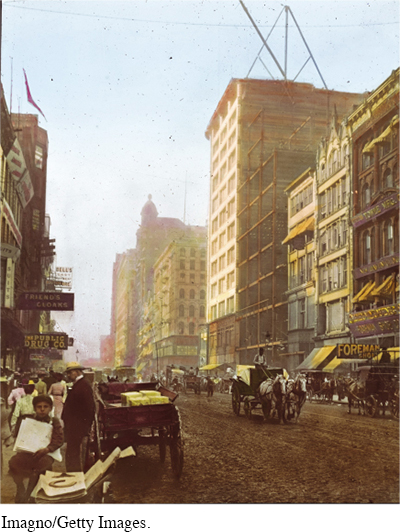The American Promise: Printed Page 549
The American Promise, Value Edition: Printed Page 504
The American Promise: A Concise History: Printed Page 571
Building Cities of Stone and Steel
The American Promise: Printed Page 549
The American Promise, Value Edition: Printed Page 504
The American Promise: A Concise History: Printed Page 571
Page 549Skyscrapers and mighty bridges dominated the imagination and the urban landscape. Less imposing but no less significant were the paved streets, the parks and public libraries, and the subways and sewers. In the late nineteenth century, Americans rushed to embrace new technology of all kinds, making their cities the most modern in the world.
Structural steel made enormous advances in building possible. A decade after the completion of the Brooklyn Bridge, engineers used the new technology to construct the Williamsburg Bridge. More prosaic and utilitarian than its neighbor, the new bridge was never as acclaimed, but it was longer by four feet and completed in half the time. It became the model for future building as the age of steel supplanted the age of stone and iron.
Chicago, not New York, gave birth to the modern skyscraper. Rising from the ashes of the Great Fire of 1871, which destroyed three square miles and left eighteen thousand people homeless, Chicago offered a generation of skilled architects and engineers the chance to experiment. Commercial architecture became an art form at the hands of a skilled group of architects who together constituted the “Chicago school.” Employing the dictum “Form follows function,” they built startlingly modern structures.

Across the United States, municipal governments undertook public works on a scale never before seen. They paved streets, built sewers and water mains, replaced gas lamps with electric lights, ran trolley tracks on the old horsecar lines, and dug underground to build subways, tearing down the unsightly elevated tracks that had clogged city streets. Boston completed the nation’s first subway system in 1897, and New York and Philadelphia soon followed.
The American Promise: Printed Page 549
The American Promise, Value Edition: Printed Page 504
The American Promise: A Concise History: Printed Page 571
Page 550Cities became more beautiful with the creation of urban public parks to complement the new buildings that quickly filled city lots. Much of the credit for America’s greatest parks goes to one man—
American cities did not overlook the mind in their efforts at improvement. They created a comprehensive free public school system that educated everyone from the children of the middle class to the sons and daughters of immigrant workers. Yet the exploding urban population strained the system and led to crowded and inadequate facilities. In 1899, more than 544,000 pupils attended school in New York’s five boroughs. Municipalities across the United States provided free secondary school education for all who wished to attend, even though only 8 percent of Americans completed high school.
To educate those who couldn’t go to school, American cities created the most extensive free public library system in the world. In 1895, the Boston Public Library opened its bronze doors in its new Copley Square location under the inscription “Free to All.” Designed in the style of a Renaissance palazzo, with more than 700,000 books on the shelves ready to be checked out, the library earned the description “a palace of the people.”
Despite the Boston Public Library’s legend “Free to All,” the poor did not share equally in the advantages of city life. The parks, the libraries, and even the subways and sewers benefited some city dwellers more than others. Few library cards were held by Boston’s laborers, who worked six days a week and found the library closed on Sunday. And in the 1890s, there was nothing central about New York’s Central Park. It was a four-
Any story of the American city, it seems, must be a tale of two cities—